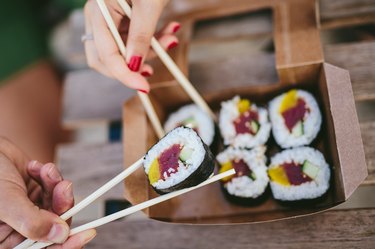
Sushi wears a few hats: After all, it's the perfect date-night dish, comfort food and healthy snack.
But those following a gluten-free diet may not have the same perspective. Although there are plenty of gluten-free rolls out there, finding them can be tricky. Read on to learn which sushi is gluten-free and how you can enjoy this meal safely.
Video of the Day
Video of the Day
Is Sushi Gluten-Free?
Those following a gluten-free diet must steer clear of any wheat, rye or barley and these grains' derivatives. But when it comes to sushi (or any restaurant food), finding gluten-free options can get complicated.
For the most part, standard sushi is made with a few simple ingredients, according to The Kitchen Community:
- Rice: In its natural, plain form, rice is gluten-free and safe to eat.
- Fish: So long as the fish is unseasoned with no added ingredients, it's free of gluten.
- Seaweed: Most sushi is wrapped in seaweed, a gluten-free plant.
- Vegetables: Different rolls have different vegetables packed inside, yet all veggies are naturally free of gluten.
Warning
Avoid the following common sushi ingredients:
- Fake crab meat (aka surimi): It usually contains wheat-based ingredients and shows in up California rolls as well as others.
- Tempura: Some rolls also contain tempura-based fish or vegetables, which are battered and fried. In most cases, the batter used contains wheat, making these rolls unsafe to eat for people with celiac disease or those with gluten intolerance.
- Soy sauce: The popular sauce isn't actually gluten-free because most companies use wheat in their product. The same goes for other common sushi sauces, too.
- Teriyaki sauce: Some teriyaki sauce products contain soy sauce in their recipe.
- Marinated fish (like unagi): These are often marinated in soy sauce, which is not gluten-free.
- Rice vinegar: In some cases, rice vinegar may contain gluten, according to the National Celiac Association.
Depending on the type of sushi you order or buy, different restaurants and companies may add gluten-containing ingredients to their recipes.
Or, they may prepare their rolls in a restaurant that also handles gluten-containing foods — and that puts your sushi at risk of cross-contamination, according to the Celiac Disease Foundation.
How to Find Gluten-Free Sushi
At the Supermarket
You can prevent and avoid gluten cross-contamination by checking the packaging and reading the nutrition label on the sushi you buy at the grocery store.
Look for a "gluten-free" label on the front of the package. This label is regulated by the U.S. Food & Drug Administration and signifies that the food you're eating has less than 20 parts per million (ppm) of gluten, which is generally safe for people with celiac and gluten sensitivity.
If you want even higher standards, buy foods that are certified gluten-free by trusted third parties, such as the Gluten-Free Certification Organization (GFCO). The GFCO has especially strict standards, certifying foods that have only 10 ppm of gluten or less, according to the organization's website.
If your package of sushi doesn't have a gluten-free label, check the allergen listing for any wheat, rye or barley.
At a Restaurant
Ordering sushi at a restaurant can be tricky due to the risk of cross-contact. You'll want to speak with your waiter (or the chef) to guarantee the sushi you get is free of gluten and contaminants. Then, make sure you're also served gluten-free soy sauce.
In some cases, you may be able to find a gluten-free-specific sushi restaurant, which is your best bet. These establishments are definitely a safer bet, taking extra precautions to ensure all their foods are safe to eat, according to the National Celiac Association.
Check the "avoid" list above to know what to skip ordering.